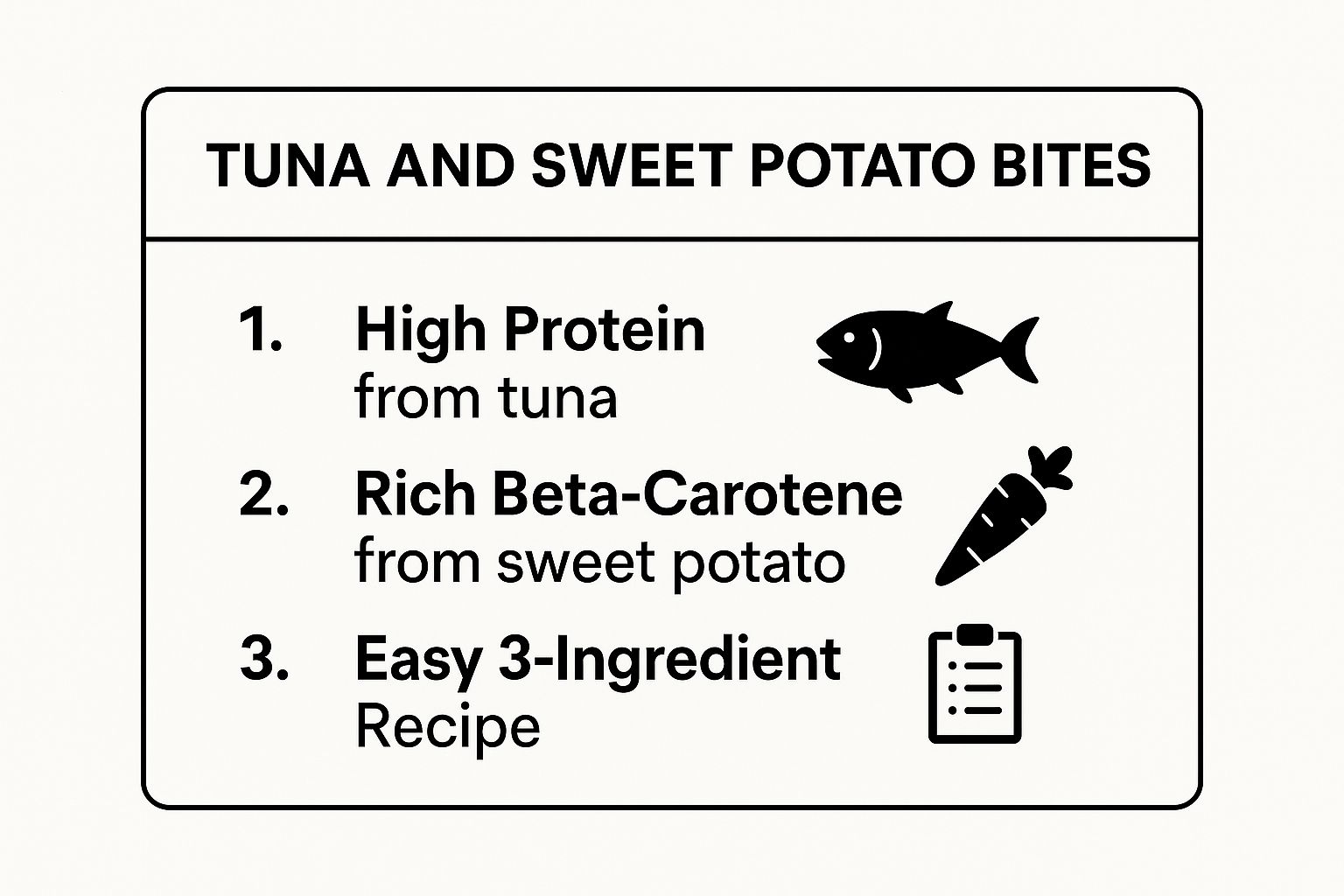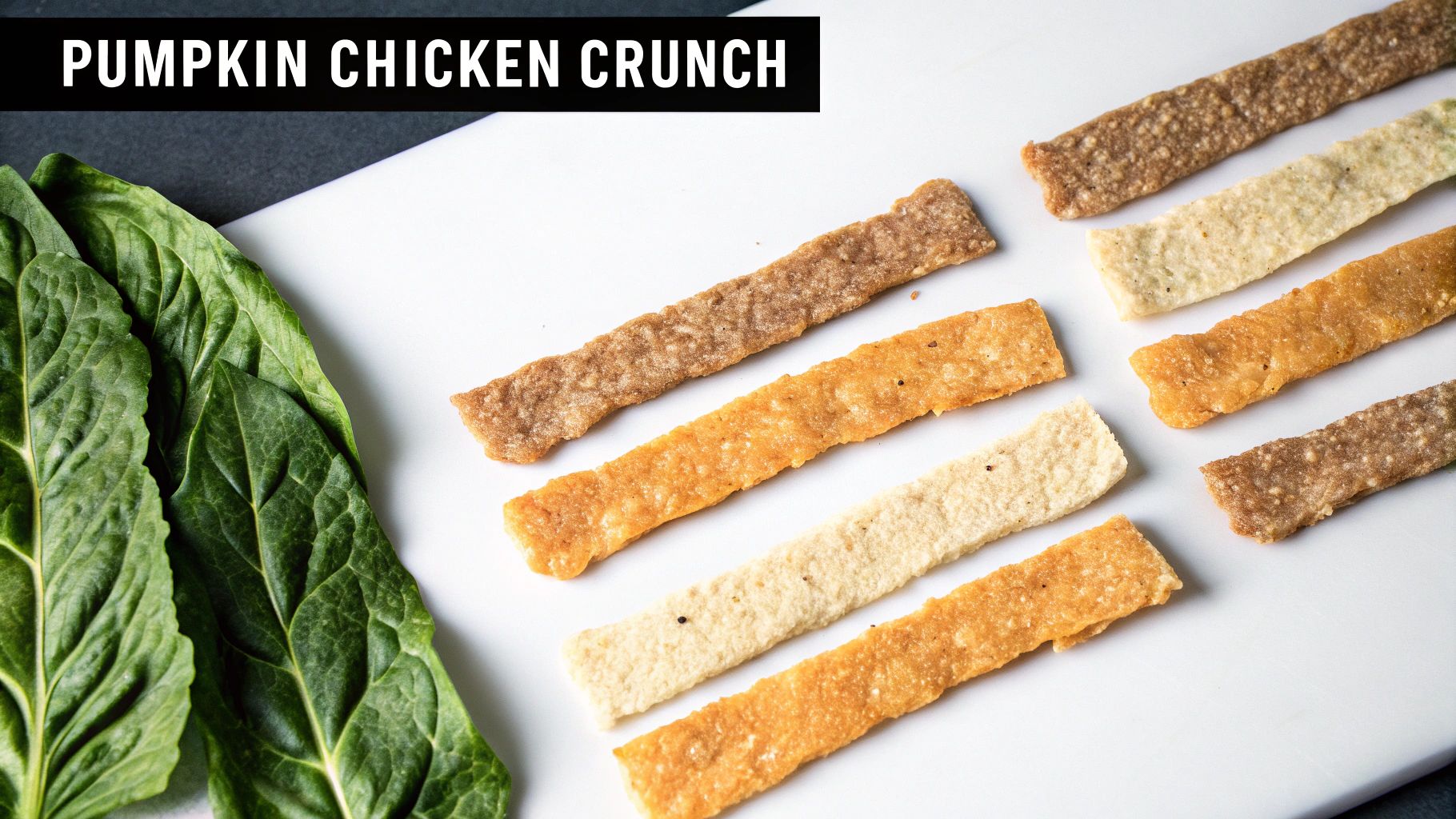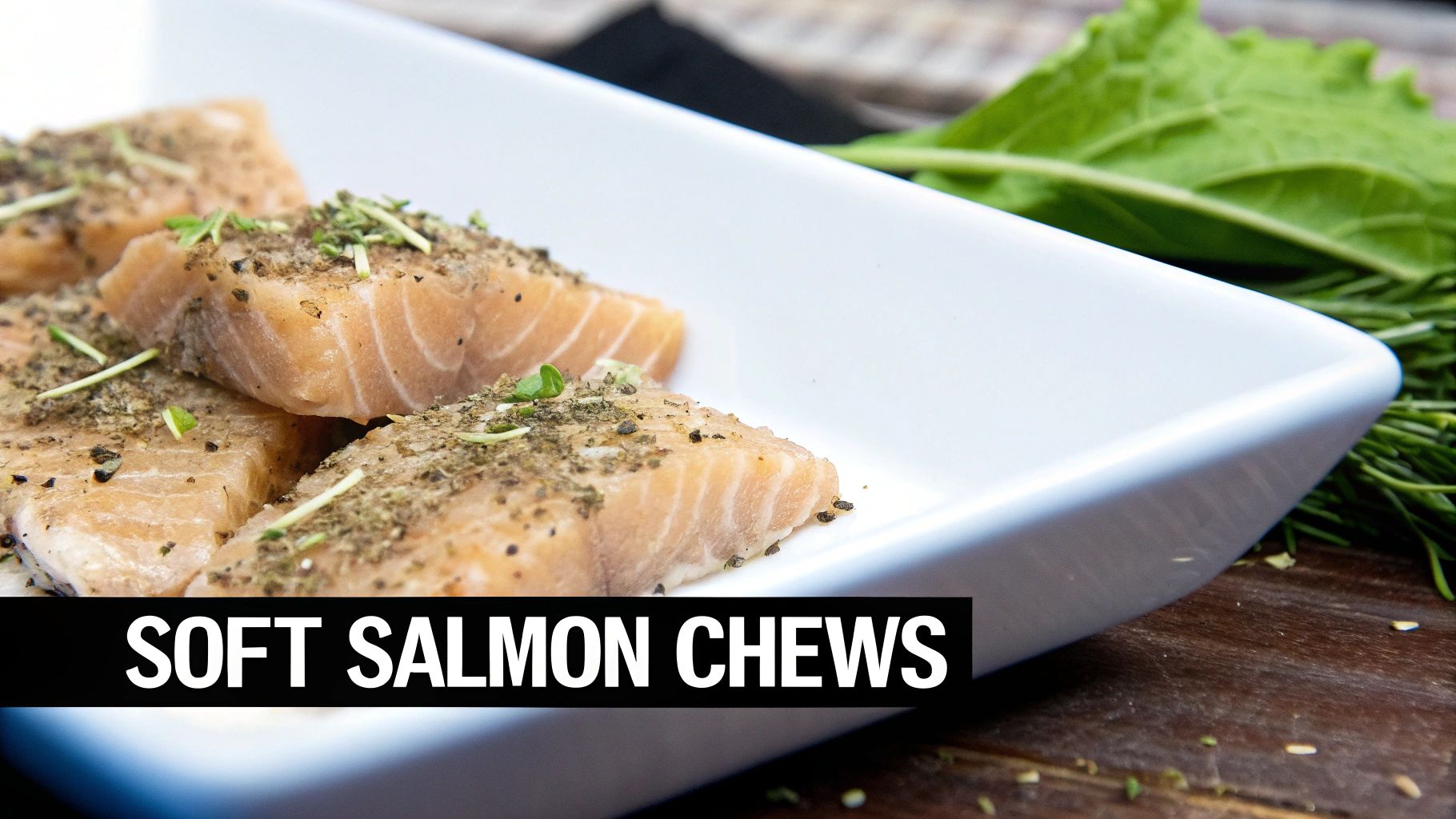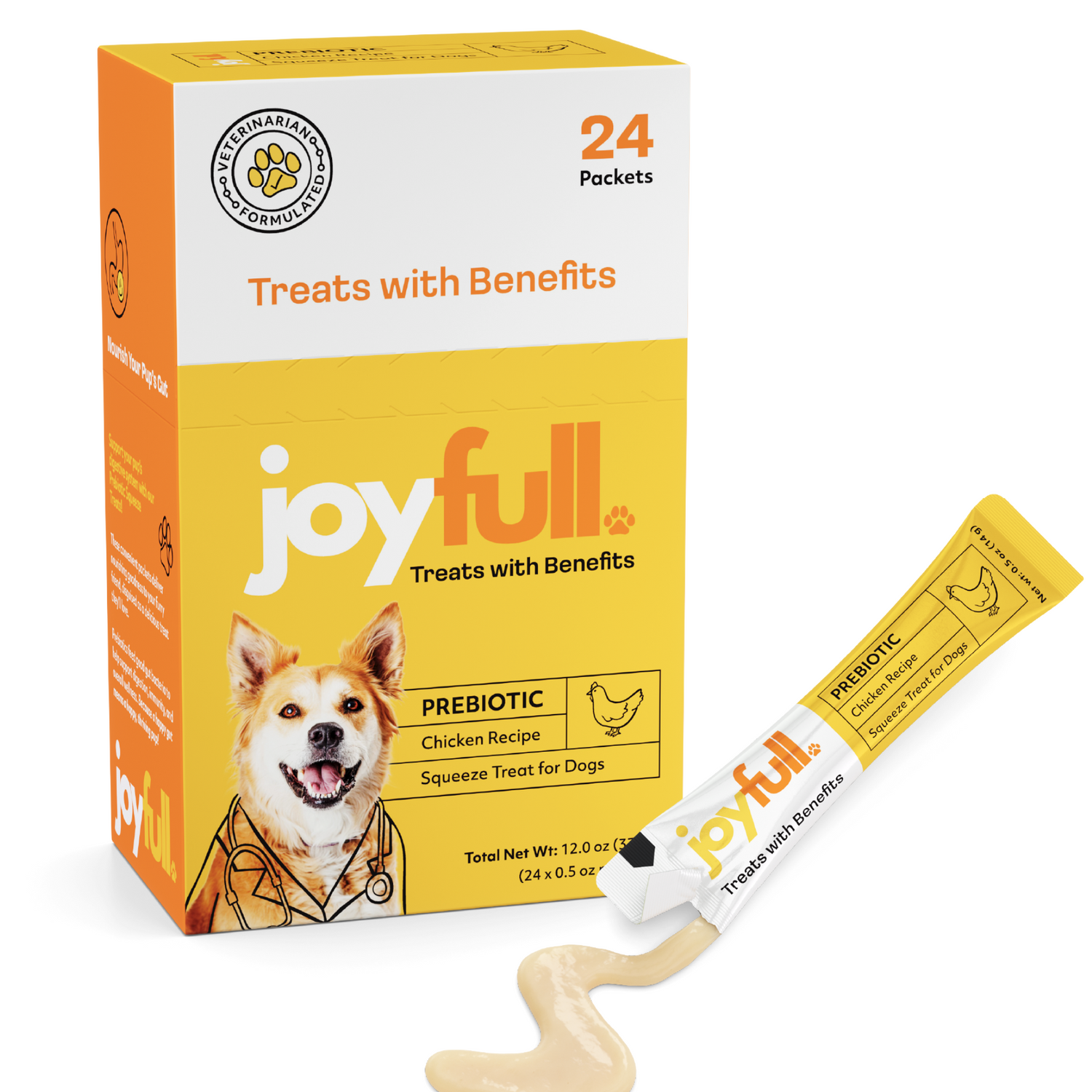
Top 6 Homemade Cat Treat Recipes for Happy Pets in 2025
Spoiling your feline friend with treats is one of the simple joys of pet ownership, but navigating the world of store-bought options can be frustrating. Vague ingredient lists, unnecessary fillers, and artificial additives often leave you wondering what you're actually feeding your cat. Creating your own snacks puts you in complete control, ensuring every bite is packed with wholesome, species-appropriate nutrition. This guide offers a collection of simple yet delicious homemade cat treat recipes designed to nourish your pet from the inside out.
By preparing treats at home, you can tailor recipes to your cat’s specific dietary needs and preferences, avoiding common allergens or ingredients that don't agree with their system. It's a direct way to enhance their diet with high-quality protein and beneficial nutrients without the mystery additives found in many commercial products. This hands-on approach not only benefits your cat's health but also deepens the bond you share. Taking the time to craft something special for them is a powerful expression of care. For those who cherish their furry companions, exploring more ways to express that love is always rewarding. Beyond homemade treats, you might find inspiration in this guide to thoughtful gifts for animal lovers.
In this roundup, you will discover six vet-approved recipes that are easy to prepare and irresistible to cats. Each recipe features a clean-ingredient formula, step-by-step instructions, and wellness tips to maximize health benefits. Get ready to transform your kitchen into your cat’s favorite bakery with these protein-rich and flavorful options:
- Tuna and Sweet Potato Bites: A classic combination rich in omega-3s.
- Chicken and Pumpkin Freeze-Dried Style Treats: Perfect for sensitive stomachs.
- Salmon and Catnip Soft Chews: An enticing treat for training or picky eaters.
- Liver and Rice Protein Balls: A nutrient-dense option for active cats.
- Sardine and Oat Crunchy Cookies: Packed with calcium and healthy fats.
- Turkey and Cranberry Thanksgiving Bites: A festive treat with urinary health benefits.
1. Tuna and Sweet Potato Bites
Kicking off our list of homemade cat treat recipes is a simple yet powerfully nutritious option: Tuna and Sweet Potato Bites. This recipe leverages two ingredients that are highly appealing and beneficial for felines. It combines the savory, high-protein punch of tuna with the vitamin-rich, fibrous qualities of sweet potato, creating a treat that is both delicious and supportive of your cat's overall health.
The core of this recipe is its simplicity. By mixing flaky, canned tuna with thoroughly cooked and mashed sweet potato, you create a soft, pliable dough. A small amount of a cat-safe flour, such as whole wheat or oat flour, acts as a binder, helping the treats hold their shape during baking. The result is a batch of soft, chewy bites that are easy for cats of all ages to enjoy.
Why This Recipe Works for Cats
The appeal of these treats lies in their nutritional synergy. Tuna is an excellent source of lean protein and omega-3 fatty acids, which are vital for maintaining a healthy coat, sharp vision, and strong cognitive function. Sweet potatoes are packed with fiber for digestive health and beta-carotene, an antioxidant that the body converts into Vitamin A. This combination makes the treats more than just a tasty morsel; they are a functional supplement to your cat's diet.
Pro Tip: This recipe is particularly effective for administering medication. The strong scent of tuna can mask the smell of pills, and the soft texture allows you to easily hide a small tablet inside a treat. This technique is often used in veterinary clinics to make medication time less stressful for both cats and their owners.
Preparation and Storage Tips
To ensure these treats are safe and enjoyable for your feline friend, follow these key preparation steps:
- Choose the Right Tuna: Always use canned tuna packed in water, not oil. The high fat content in oil-packed tuna can lead to an upset stomach.
- Cook Sweet Potato Thoroughly: The sweet potato must be fully cooked (steamed or boiled) until it is very soft. This makes it easy to mash and, more importantly, easy for your cat to digest.
- Keep Bites Small: Form the treats into small, pea-sized pieces. This prevents overfeeding and reduces any potential choking hazard, especially for smaller cats or kittens.
- Test for Tolerance: When introducing any new food, start with a single, small treat to see how your cat reacts. Monitor for any signs of digestive upset.
This visual summary highlights the primary benefits of making Tuna and Sweet Potato Bites for your cat.

As the graphic illustrates, the recipe's strength lies in its combination of high-value protein, essential vitamins, and incredible simplicity. These three elements make it an ideal starting point for anyone new to making homemade cat treat recipes. For storage, place the cooled treats in an airtight container and keep them in the refrigerator for up to one week.
2. Chicken and Pumpkin Freeze-Dried Style Treats
Next on our list of homemade cat treat recipes is a crunchy, high-value option that mimics popular commercial freeze-dried products: Chicken and Pumpkin Freeze-Dried Style Treats. This recipe combines the lean, muscle-building power of chicken with the digestive benefits of pumpkin puree. By using a slow dehydration or low-temperature baking process, you can create crispy, shelf-stable treats that cats find irresistible.

The method involves coating very thin slices of cooked chicken breast in a light layer of pure pumpkin puree and then slowly drying them out until they are brittle. The dehydration concentrates the savory chicken flavor and creates a satisfying snap that many felines love. This process results in a lightweight, nutrient-dense reward that is perfect for training or as a special snack.
Why This Recipe Works for Cats
The success of this recipe lies in its texture and potent aroma. Chicken is a primary source of high-quality animal protein, essential for a cat's carnivorous dietary needs, supporting everything from muscle maintenance to energy levels. Pumpkin is a well-known source of soluble fiber, which can help regulate digestion, prevent hairballs, and promote overall gut health.
The freeze-dried style crunch is also a major draw. Unlike soft treats, the crispy texture can be more engaging for cats and can even provide a mild cleaning action for their teeth. This single-ingredient protein focus makes it an excellent choice for cats with sensitivities to grains or other common fillers found in store-bought treats.
Pro Tip: This recipe is highly effective for positive reinforcement training. Cat behaviorists often use high-value rewards like these to teach complex behaviors or build confidence in shy cats. The strong smell and desirable crunch make them more motivating than standard kibble.
Preparation and Storage Tips
To create safe and crispy treats that your cat will adore, keep these preparation guidelines in mind:
- Use Pure Pumpkin: Only use 100% pure pumpkin puree, not pumpkin pie filling. Pie filling contains sugar, spices, and other additives that are harmful to cats.
- Slice Chicken Thinly: For even and efficient dehydration, slice the cooked chicken breast as thinly as possible. Uniform thickness ensures all pieces become crispy at the same time.
- Low and Slow is Key: Whether using a dehydrator or an oven, maintain a very low temperature (around 170°F or 75°C). This removes moisture without overcooking the chicken, preserving nutrients and creating the ideal brittle texture.
- Test for Doneness: The treats are ready when they are completely dry and snap easily when bent. If they are still pliable, they need more time, as any remaining moisture can lead to mold.
For long-term storage, place the completely cooled treats in an airtight container. Adding a food-safe silica gel packet will absorb any ambient moisture and help maintain their crispiness for several weeks. For senior cats or those with dental issues, you can slightly rehydrate a treat with a drop of water to soften it before serving.
3. Salmon and Catnip Soft Chews
For a treat that stimulates both the palate and the mind, our Salmon and Catnip Soft Chews are an exceptional choice in our lineup of homemade cat treat recipes. This recipe pairs the robust flavor and omega-rich profile of salmon with the alluring excitement of catnip, creating a multi-sensory experience for your feline companion. The soft, chewy texture makes these treats particularly suitable for senior cats or those with dental sensitivities.

The recipe foundation is simple: canned salmon, an egg for binding, and a small amount of flour create a pliable dough that bakes into a tender chew. The addition of dried catnip transforms it from a simple snack into an enriching reward. This combination has been successfully used in senior cat care facilities to encourage eating and provide gentle enrichment for less active felines.
Why This Recipe Works for Cats
The effectiveness of these treats lies in their dual-purpose ingredients. Salmon is packed with omega-3 fatty acids, which are crucial for reducing inflammation, supporting joint health, and maintaining a glossy coat. Catnip contains nepetalactone, a compound that triggers a euphoric response in many cats, promoting playfulness and helping to reduce stress. This makes the treats a powerful tool for behavioral enrichment and positive reinforcement. Feline behaviorists often recommend catnip-infused treats to help anxious cats relax in new environments or during stressful events.
Pro Tip: These soft chews are an excellent post-procedure reward. Veterinary dentists sometimes suggest soft, palatable treats like these for cats recovering from dental work, as they are gentle on sensitive gums while still being highly motivating for the cat to eat.
Preparation and Storage Tips
To create safe and irresistible Salmon and Catnip Soft Chews, keep these preparation guidelines in mind:
- Select Quality Salmon: Opt for canned salmon packed in water, not oil, to avoid digestive upset. Wild-caught salmon is preferable as it often has a higher concentration of omega-3s.
- Test Catnip Sensitivity: Not all cats react to catnip. Before making a large batch, offer a tiny pinch of your dried catnip to your cat to gauge their interest and reaction.
- Start with Less Catnip: Use catnip sparingly at first, especially if your cat is new to it. A small amount is all that is needed to produce the desired effect.
- Shape for Safety: Form the dough into small, flat, disc-like shapes or tiny morsels. This makes them easy to chew and swallow, minimizing any risk of choking.
For those interested in exploring similar wellness-focused options, you can find more information about Salmon and Catnip Soft Chews on joyfullpet.com. When it comes to storage, allow the chews to cool completely before placing them in an airtight container. They should be stored in the refrigerator and will remain fresh for up to five days.
4. Liver and Rice Protein Balls
Next on our list of homemade cat treat recipes is a powerhouse of nutrition: Liver and Rice Protein Balls. This recipe capitalizes on the exceptional nutrient density of organ meat, offering a treat that is intensely appealing to a cat's carnivorous nature. By combining cooked chicken or beef liver with a simple binder like cooked rice, you create a treat that is rich in essential vitamins and minerals.
The foundation of this recipe is its high-value primary ingredient. Liver is minced or pureed after being thoroughly cooked and then mixed with warm, cooked rice. The warmth of the ingredients helps them bind together, forming a mixture that can be easily rolled into small, bite-sized balls. This straightforward process results in a soft, moist treat that is packed with flavor and vital nutrients.
Why This Recipe Works for Cats
The incredible appeal of this recipe lies in liver's status as a superfood for felines. Liver is one of nature's most concentrated sources of vitamin A, B-complex vitamins (especially B12), iron, and other essential minerals. These nutrients are critical for supporting vision, energy production, red blood cell formation, and overall immune system function. Rice provides a gentle, easily digestible carbohydrate that gives the treats structure without upsetting a sensitive stomach.
Pro Tip: Due to their high nutritional value and potent aroma, these treats are exceptionally effective as high-value rewards. They are successfully used in challenging situations, such as socializing timid cats, training, and even in Trap-Neuter-Return (TNR) programs to safely lure feral cats. Veterinarians may also recommend them for anemic cats due to the high iron content.
Preparation and Storage Tips
To create safe and potent Liver and Rice Protein Balls, it is crucial to follow these preparation guidelines:
- Cook Liver Thoroughly: Raw liver can harbor harmful bacteria like Salmonella. Always cook chicken or beef liver completely (by boiling or pan-frying without oil) until it is no longer pink inside.
- Start with Small Portions: Liver is extremely rich, and too much can cause digestive upset or lead to vitamin A toxicity over time. Limit your cat to one or two small, pea-sized treats per day.
- Mix While Warm: Combine the minced liver and cooked rice while both are still warm. This helps the starches in the rice bind with the liver, making it easier to form the balls.
- Wear Gloves for Prep: Liver has a strong smell and can be messy to handle. Wearing disposable gloves during preparation can make the process much cleaner and more pleasant.
The combination of liver and rice creates a powerful, high-protein snack that serves as a beneficial supplement to a balanced diet. For pet owners looking for more ways to incorporate high-quality protein, this guide to high-protein cat treats on joyfullpet.com offers additional insights and options. To store these protein balls, place them in an airtight container in the refrigerator, where they will stay fresh for up to five days.
5. Sardine and Oat Crunchy Cookies
For those looking to add a satisfying crunch to their feline's snack time, our next entry in this guide to homemade cat treat recipes is a standout: Sardine and Oat Crunchy Cookies. This recipe creates a biscuit-style treat that combines the potent, fishy aroma of whole sardines with the hearty texture of rolled oats. The result is a nutrient-dense cookie that supports everything from bone strength to cardiovascular health.
The process involves mashing whole sardines and blending them with oat flour to form a simple, rollable dough. Unlike softer treats, these are baked until firm and crunchy, offering a different textural experience that many cats enjoy. The strong scent is highly attractive to felines, making these cookies an instant hit in most households.
Why This Recipe Works for Cats
The nutritional powerhouse behind these treats is the sardine. Sardines are an exceptional source of omega-3 fatty acids, which are crucial for reducing inflammation and maintaining a healthy heart and shiny coat. Because the recipe calls for using the entire fish, including the soft, edible bones, it provides a significant, natural source of calcium for strong teeth and bones. Oats contribute soluble fiber for digestive regularity and B vitamins for energy metabolism.
Pro Tip: These crunchy cookies can also play a role in feline dental health. The abrasive, crunchy texture helps to scrape away plaque and tartar as your cat chews, which can contribute to better oral hygiene between professional cleanings. This makes them a great functional treat for adult and senior cats.
Preparation and Storage Tips
To create the perfect batch of Sardine and Oat Crunchy Cookies, keep these guidelines in mind:
- Select Water-Packed Sardines: Always purchase sardines packed in water with no added salt. Varieties packed in oil, mustard, or tomato sauce contain ingredients that can be harmful or cause digestive upset in cats.
- Mash the Bones Thoroughly: Ensure you mash the sardines completely, crushing the tiny, soft bones into the paste. These bones are a key source of calcium and are perfectly safe for cats to consume once broken down.
- Roll the Dough Thin: For maximum crunch, roll the dough out to about 1/8-inch thickness before cutting out your shapes. A thinner cookie will bake up crispier and be easier for cats to break apart.
- Size Appropriately: Cut the cookies into small, bite-sized pieces before baking. Once baked, you can break larger cookies into smaller morsels suitable for your cat’s size to prevent overfeeding.
This recipe is not just a tasty indulgence; it's a way to provide targeted nutritional support, especially for senior cats who benefit from extra joint and bone support. If you want to dive deeper into what makes a treat truly beneficial for your feline, you can explore more about what are good cat treats on joyfullpet.com. For storage, allow the cookies to cool completely before placing them in an airtight container. They will stay fresh at room temperature for up to two weeks due to their low moisture content.
6. Turkey and Cranberry Thanksgiving Bites
Bringing the festive flavors of the holidays to your feline's treat jar, our next recipe is for Turkey and Cranberry Thanksgiving Bites. This recipe is a thoughtful blend of ingredients that mirrors a holiday meal while providing targeted health benefits for your cat. It features lean ground turkey, antioxidant-rich cranberries, and a subtle hint of aromatic sage, creating a special treat that is both delicious and wholesome.
The foundation of this recipe is cooked, lean ground turkey, mixed with finely chopped, unsweetened cranberries and a very small amount of dried sage. A binder like oat flour or even a single egg yolk can be used to form a cohesive dough. These ingredients are then portioned into tiny, bite-sized pieces and baked until firm, resulting in a savory, slightly sweet treat that captures a unique flavor profile cats find intriguing.
Why This Recipe Works for Cats
The effectiveness of these treats stems from their unique and beneficial ingredients. Turkey is an excellent source of lean protein that is often easier for cats to digest than chicken, making it a great option for felines with sensitive stomachs or those transitioning to new protein sources. Cranberries are well-known for their proanthocyanidins, which help support urinary tract health by preventing certain bacteria from adhering to the bladder wall. Sage adds an appealing aroma and contains natural antimicrobial properties.
Pro Tip: These treats are an excellent choice for cats prone to urinary tract issues. While they are not a substitute for veterinary care, the inclusion of cranberries can be a proactive, dietary step in supporting a healthy urinary system. Veterinarians often recommend incorporating cranberries into the diets of susceptible cats as a preventative measure.
Preparation and Storage Tips
To create safe and delicious Turkey and Cranberry Thanksgiving Bites, pay close attention to these preparation guidelines:
- Use Unsweetened Cranberries: It is crucial to use only unsweetened dried or fresh cranberries. Sugars and artificial sweeteners like xylitol are harmful to cats.
- Cook Turkey Thoroughly: Ensure the ground turkey is fully cooked with no pink parts remaining before you mix it with the other ingredients. This eliminates the risk of salmonella and other foodborne bacteria.
- Use Sage Sparingly: Sage has a strong aroma and flavor. A very small amount, typically less than 1/4 teaspoon for a whole batch, is all that's needed. Too much can be overwhelming for a cat's sensitive palate.
- Chop Cranberries Finely: Finely dicing the cranberries ensures they are evenly distributed throughout the treats, preventing any single bite from being too tart and making them easier to digest.
These treats offer a fantastic way to include your cat in holiday celebrations with a safe, species-appropriate snack. For storage, let the bites cool completely before placing them in an airtight container. They can be stored in the refrigerator for up to a week or frozen for up to three months, making this one of the more versatile homemade cat treat recipes for planning ahead.
Homemade Cat Treats Recipe Comparison
| Treat Name | Implementation Complexity 🔄 | Resource Requirements ⚡ | Expected Outcomes 📊 | Ideal Use Cases 💡 | Key Advantages ⭐ |
|---|---|---|---|---|---|
| Tuna and Sweet Potato Bites | Low - Simple 3-ingredient recipe | Minimal - Common pantry items | Balanced nutrition with protein & beta-carotene | Medication administration, training rewards, socialization | Highly palatable, grain-free, easy prep, long shelf life |
| Chicken and Pumpkin Freeze-Dried | High - Requires dehydrator or low-heat baking | Moderate - Needs dehydrator/oven | Crunchy, flavorful, digestive aid | Positive reinforcement training, post-surgery appetite | Long shelf life, strong aroma for training, low carb |
| Salmon and Catnip Soft Chews | Medium - Baking with soft chew texture | Moderate - Requires fresh salmon, catnip | Soft texture, omega-3 benefits, behavioral enrichment | Senior cats, dental sensitive cats, stress relief | Easily digestible, mental stimulation, skin & coat support |
| Liver and Rice Protein Balls | Medium - cooking liver and binding | Moderate - Liver and rice | Nutrient-dense, vitamin & mineral rich | Reproductive health, anemic cats, high-value rewards | Extremely nutritious, cost-effective, highly palatable |
| Sardine and Oat Crunchy Cookies | Medium - Baking biscuits | Moderate - Sardines and oats | Crunchy for dental benefits, calcium & omega-3 rich | Heart health support, senior cat nutrition, dental care | Dental benefits, sustainable protein, antioxidant rich |
| Turkey and Cranberry Thanksgiving Bites | Medium - Baking, mixing seasonal ingredients | Moderate - Turkey, cranberries, herbs | Lean protein with antioxidants, urinary tract support | Holiday treats, urinary health, protein transition | Low fat, antioxidant-rich, sensory enrichment |
Your Next Steps to Treat Success
Embarking on the journey of creating your own homemade cat treat recipes is more than just a culinary experiment; it's a profound way to deepen the bond with your feline companion. By taking control of the ingredients, you are directly investing in their health, happiness, and overall well-being. The recipes we've explored, from the protein-packed Tuna and Sweet Potato Bites to the festive Turkey and Cranberry Thanksgiving Bites, provide a solid foundation for you to become your cat's personal chef.
Remember, the key to success lies in understanding your cat's unique preferences and dietary needs. What sends one cat into a purring frenzy might get a lukewarm reception from another. This process is one of discovery, allowing you to learn more about your pet's tastes while ensuring every bite is both delicious and nutritious.
Key Takeaways for Feline-Friendly Baking
As you move from reading to baking, keep these core principles at the forefront of your efforts. They are the cornerstones of safe, successful, and satisfying treat-making.
- Safety First, Always: Before introducing any new ingredient into your cat's diet, a quick consultation with your veterinarian is crucial. This step is non-negotiable, especially for cats with pre-existing health conditions, allergies, or dietary sensitivities.
- Ingredient Quality Matters: The quality of your treats is directly tied to the quality of your ingredients. Opt for fresh, whole foods like lean meats, fish packed in water, and cat-safe vegetables. Avoid artificial preservatives, colors, and sweeteners like xylitol, which is highly toxic to pets.
- Portion Control is Paramount: Homemade treats are delightful, but they are supplemental to a balanced diet. Treats should constitute no more than 10% of your cat’s daily caloric intake to prevent weight gain and nutritional imbalances.
- Proper Storage Preserves Freshness: To prevent spoilage and maintain optimal flavor and texture, store your finished treats in an airtight container. Refrigeration is best for most recipes, typically keeping them fresh for up to a week, while freezing can extend their shelf life for several months.
Putting Knowledge into Action: Your Culinary Blueprint
Now that you're armed with recipes and best practices, it's time to preheat the oven and get started. Begin by selecting one recipe that you think will most appeal to your cat. Did they go wild for the Sardine and Oat Crunchy Cookies, or are they more of a fan of the Salmon and Catnip Soft Chews?
Gather your high-quality ingredients and follow the step-by-step instructions carefully. Pay close attention to your cat's reaction during the taste test. Their response is the most valuable feedback you can receive. This hands-on experience not only builds your confidence but also fine-tunes your approach for future baking adventures. Once you've mastered these recipes, you might even consider making your homemade treats as delightful additions to your cat stocking stuffers during the holiday season, offering a truly personal and heartfelt gift.
Ultimately, mastering homemade cat treat recipes empowers you to provide tailored nutrition and express your love in a tangible, tasty way. It's a rewarding skill that benefits both you and your cherished pet, turning simple kitchen moments into lasting memories.
For those times when your schedule is tight but you still want to provide the best, Joyfull offers a perfect solution. Our treats are crafted with the same whole-food philosophy you use in your own kitchen, featuring clean, simple ingredients for on-the-go wellness. Explore the full range of better-for-you pet treats at Joyfull and give your pet the genuine nutrition they deserve, anytime.

